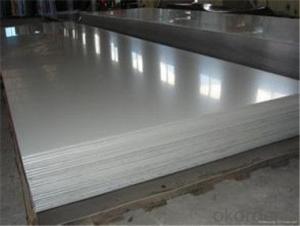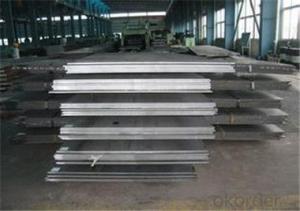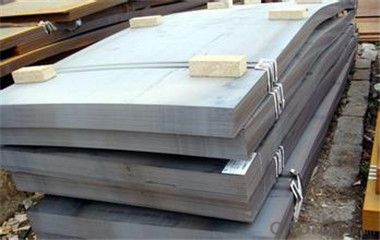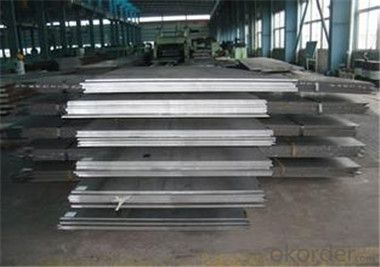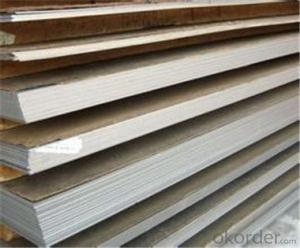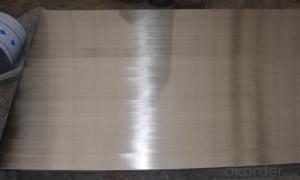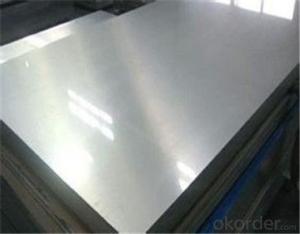Stainless Steel Sheet AISI 316 with Best Quality in China
- Loading Port:
- Tianjin
- Payment Terms:
- TT OR LC
- Min Order Qty:
- 50 m.t.
- Supply Capability:
- 45555555 m.t./month
OKorder Service Pledge
OKorder Financial Service
You Might Also Like
Specification
Description of stainless steel plate:
316L stainless steel containing molybdenum species, the steel containing molybdenum, the overall performance is better than steel 310 and 304 stainless steel, high temperature conditions, when the sulfuric acid concentration is less than 15% or greater than 85%, 316L stainless steel with a wide range of purposes. 316L stainless steel also has good resistance to chloride corrosion performance, it is usually used in the marine environment.
Festures of stainless steel plate:
| Packaging Details: | standard packing to export 4 eye bands and 3 circumferential bands in steel, galvanized metal fluted rings on inner and outer edges, galvanized metal & waterproof paper wall protection disk, galvanized metal & waterproof paper around circumference |
| Delivery Detail: | 15-25 days after received your deposit or to your quantity |
Specifications of stainless steel plate:
Product Name | cr 1219x2438 stanless steel sheet 201 |
standared | JIS, AISI, ASTM, GB, DIN,SUS |
Thickness | 0.2mm~2.5mm |
Size | 1000*2000mm,1219*2438mm or as per customers' request |
Surface finish | 2B, BA, Hair Line, No.1,No.4, Mirror Finish |
Application | Kitchenware, decoration construction and building ornament, product parts manufacturing and stainless steel products tooling and so on |
Payment terms | T/T 30% for deposit, Balance against the copy of B/L; or L/C at sight |
Product Packing | wooden pallet |
Delivery time | within 15-20 working days after we got your 30% deposit |
Attention | FREE SAMPLES can be sent on request. |
Images of stainless steel plate:
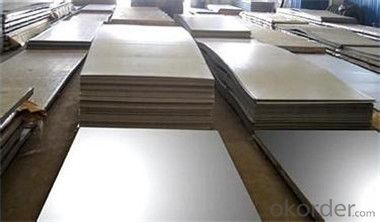
FAQ:
1. What is your package?
Packing situation: standard seaworthy packing or as customer required.
2. How long is the lead time?
Delivery time: 45 days after order confirmed.
3. What payment term do you accept?
Payment: T/T or L/C at sight.
- Q: What are the different types of steel wire rod surface cleaning methods after wire drawing?
- There are several types of steel wire rod surface cleaning methods after wire drawing, including mechanical cleaning methods such as shot blasting, wire brushing, and sanding. Chemical cleaning methods like pickling and acid washing can also be used. Additionally, thermal cleaning methods like annealing and heat treatment can help remove impurities and improve the surface quality of the steel wire rod.
- Q: What are the main factors affecting the toughness of steel wire rod?
- The main factors affecting the toughness of steel wire rod are the composition of the steel, the heat treatment process, and the presence of impurities or defects in the material.
- Q: How is steel wire rod used in the manufacturing of wire forms for wind turbines?
- Steel wire rod is used in the manufacturing of wire forms for wind turbines as it serves as the primary material for creating the structural components. These wire forms are used for various applications within the turbine, such as forming the framework for the blades, supporting the generator, and providing stability to the tower. The high tensile strength and durability of steel wire rod make it an ideal choice for withstanding the harsh environmental conditions and mechanical stresses experienced by wind turbines.
- Q: How is steel wire rod used in the production of wire strands for cable-stayed bridges?
- Steel wire rod is a crucial component in the production of wire strands for cable-stayed bridges. These wire strands are essential for providing structural stability and load-bearing capacity to the bridge. To begin with, steel wire rods are manufactured with precise chemical compositions and mechanical properties to ensure their suitability for this application. These wire rods are typically made from high-strength steel alloys, such as carbon or alloy steel, which can withstand the immense tension and stress experienced by cable-stayed bridges. The first step in the production process involves drawing the steel wire rod through a series of dies to reduce its diameter. This process, known as wire drawing, imparts a higher tensile strength to the wire strand by aligning the crystal structure of the steel and eliminating impurities. The resulting wire strand is now capable of withstanding substantial loads. Once the wire strands are formed, they are galvanized or coated with a corrosion-resistant material. This coating protects the steel from environmental factors, such as moisture and chemicals, which could cause corrosion and compromise the integrity of the bridge. After the wire strands have been coated, they are assembled into bundles to form the cable-stayed bridge's main supporting structure. The number of wire strands used, along with their arrangement and tensioning, depends on the design requirements of the specific bridge. These wire strands are typically anchored to the bridge deck and tower, providing support and distributing the load across the structure. The final step involves tensioning the wire strands to their specified levels, ensuring that they can bear the anticipated loads and maintain the bridge's stability. This tensioning process is crucial for achieving the desired sag and shape of the bridge, as well as distributing the forces evenly among the wire strands. In summary, steel wire rod plays a vital role in the production of wire strands for cable-stayed bridges. It provides the necessary strength and durability to withstand the immense loads and forces exerted on these structures. Through a series of manufacturing processes, the wire rod is transformed into wire strands that are galvanized, bundled, and tensioned to create a stable and reliable supporting system for cable-stayed bridges.
- Q: What are the advantages of using alloyed steel wire rod?
- There are several advantages of using alloyed steel wire rod. Firstly, alloying steel with other elements enhances its strength and durability, making it suitable for various applications that require high tensile strength. Secondly, alloyed steel wire rod offers improved resistance to corrosion, oxidation, and wear, making it ideal for use in outdoor or harsh environments. Additionally, alloyed steel wire rod exhibits better formability and weldability, allowing for easier processing and fabrication. Lastly, the use of alloyed steel wire rod can lead to cost savings as it often requires less maintenance and replacement compared to other materials.
- Q: What are the common applications of low alloy steel wire rod?
- Low alloy steel wire rod has various common applications due to its specific properties and characteristics. Some of the most common applications of low alloy steel wire rod include: 1. Construction industry: Low alloy steel wire rod is widely used in the construction industry for reinforcing concrete structures. It is commonly used to manufacture welded wire mesh, which is used to reinforce concrete slabs, walls, and foundations. The high strength and durability of low alloy steel wire rod make it an ideal choice for withstanding heavy loads and preventing structural failure. 2. Automotive industry: Low alloy steel wire rod is extensively used in the automotive industry for manufacturing various components. It is commonly used to produce springs, suspension systems, and other high-stress components that require excellent strength and fatigue resistance. The low alloy steel wire rod's ability to withstand heavy loads and constant stress makes it well-suited for automotive applications. 3. Manufacturing industry: Low alloy steel wire rod is also used in various manufacturing processes. It is commonly employed in the production of fasteners, such as screws, bolts, and nuts, due to its high tensile strength. Additionally, low alloy steel wire rod is used for manufacturing wire ropes, cables, and other high-strength wire products that require durability and resistance to corrosion. 4. Engineering industry: Low alloy steel wire rod finds applications in the engineering industry for fabricating structural components, machinery parts, and equipment. It is often used for manufacturing gears, shafts, and bearings due to its excellent wear resistance and ability to withstand heavy loads. The low alloy steel wire rod's properties make it a reliable choice for critical engineering applications. 5. Electrical industry: Low alloy steel wire rod is used in the electrical industry for manufacturing various electrical conductors and components. It is commonly used to produce overhead power lines, electrical cables, and wires due to its high electrical conductivity and mechanical strength. The low alloy steel wire rod's ability to carry electricity efficiently and its resistance to mechanical stress make it suitable for electrical applications. In summary, low alloy steel wire rod has a wide range of applications in the construction, automotive, manufacturing, engineering, and electrical industries. Its high strength, durability, wear resistance, and electrical conductivity make it a versatile material for various applications that require reliability and performance.
- Q: What are the advantages of using steel wire rod over other materials?
- There are several advantages of using steel wire rod over other materials. Firstly, steel wire rod offers exceptional strength and durability. Steel is known for its high tensile strength, making it ideal for applications that require a strong and reliable material. It can withstand heavy loads and stresses, making it suitable for various industries such as construction, automotive, and manufacturing. Secondly, steel wire rod is highly versatile. It can be easily fabricated into different shapes and sizes to meet specific project requirements. This flexibility allows for a wide range of applications, including wire ropes, springs, cables, fencing, and reinforcement in concrete structures. Moreover, steel wire rod has excellent corrosion resistance properties. It can resist rust and other forms of degradation, ensuring a longer lifespan and reduced maintenance costs. This makes it suitable for outdoor and marine applications, where exposure to moisture and harsh weather conditions is common. In addition, steel wire rod is cost-effective. Its abundance and widespread availability make it a cost-efficient option for various industries. Furthermore, its durability and resistance to wear and tear contribute to lower replacement and maintenance costs in the long run. Lastly, steel wire rod is environmentally friendly. Steel is one of the most recycled materials globally, and using steel wire rod promotes sustainability by reducing the need for new production. Additionally, steel's recyclability helps conserve natural resources and reduce carbon emissions. In summary, the advantages of using steel wire rod over other materials include its exceptional strength, versatility, corrosion resistance, cost-effectiveness, and environmental sustainability. These qualities make steel wire rod a preferred choice for a wide range of applications across different industries.
- Q: What are the various applications of steel wire rod?
- Steel wire rods have a wide range of applications across various industries. They are commonly used in the construction sector for reinforcing concrete structures such as buildings, bridges, and highways. Steel wire rods are also utilized in the manufacturing of automotive components, including springs, cables, and tires. Additionally, they find application in the production of wire mesh for fencing, as well as in the manufacturing of electrical wires and cables. Furthermore, steel wire rods are used in the production of various household items, such as kitchen utensils, furniture, and appliances.
- Q: What is the maximum allowable deviation in diameter for steel wire rod?
- The maximum allowable deviation in diameter for steel wire rod is determined by different industries and applications, according to their specific standards and specifications. However, generally, the maximum allowable deviation in diameter for steel wire rod is typically defined as either a percentage or a specific tolerance range. For instance, in the steel industry, the maximum allowable deviation in diameter for steel wire rod can vary from +/- 0.010 inches to +/- 0.020 inches, depending on the grade and intended use of the wire rod. This indicates that the wire rod's diameter can be slightly greater or smaller than its specified value within this tolerance range. It is important to emphasize that these tolerances can differ based on the particular requirements of the industry and the intended application of the steel wire rod. Therefore, it is crucial to refer to the industry or application's relevant standards, specifications, and guidelines to ascertain the maximum allowable deviation in diameter for steel wire rod in a specific context.
- Q: How is steel wire rod used in the manufacturing of wire for electrical grounding systems?
- Steel wire rod is an essential component in the manufacturing of wire for electrical grounding systems. These systems play a crucial role in ensuring the safety and functionality of electrical installations by providing a path for electrical currents to flow into the ground, thus preventing damage or electrical shocks. In the manufacturing process, steel wire rods are first subjected to a series of shaping and forming operations. The wire rods are typically drawn through a series of dies to reduce their diameter and achieve the desired thickness. This drawing process helps in strengthening the wire and ensuring uniformity in its dimensions. The steel wire rods used for electrical grounding systems are generally made of high-quality carbon or stainless steel to ensure durability and resistance to corrosion. Once the steel wire rods have been drawn into the desired wire size, they are then subjected to various surface treatments. These treatments can include galvanization, which involves coating the wire with a layer of zinc to enhance its corrosion resistance. Galvanization also improves the electrical conductivity of the wire, making it more efficient for grounding purposes. After the surface treatment, the wire is then cut into specific lengths and spooled onto reels or coils. These wire coils are then used in the manufacturing of electrical grounding systems, such as grounding cables, conductors, or earth electrodes. The steel wire serves as the core component, providing strength and stability to the grounding system. The wire manufactured from steel wire rod is highly versatile and can be used in various electrical grounding applications, ranging from residential and commercial buildings to industrial facilities. It is commonly used for grounding electrical equipment, machinery, and infrastructure, ensuring the safe dissipation of electrical currents. In summary, steel wire rod is a fundamental material in the production of wire for electrical grounding systems. Its strength, durability, and resistance to corrosion make it an ideal choice for ensuring the safety and functionality of electrical installations.
Send your message to us
Stainless Steel Sheet AISI 316 with Best Quality in China
- Loading Port:
- Tianjin
- Payment Terms:
- TT OR LC
- Min Order Qty:
- 50 m.t.
- Supply Capability:
- 45555555 m.t./month
OKorder Service Pledge
OKorder Financial Service
Similar products
Hot products
Hot Searches
Related keywords
